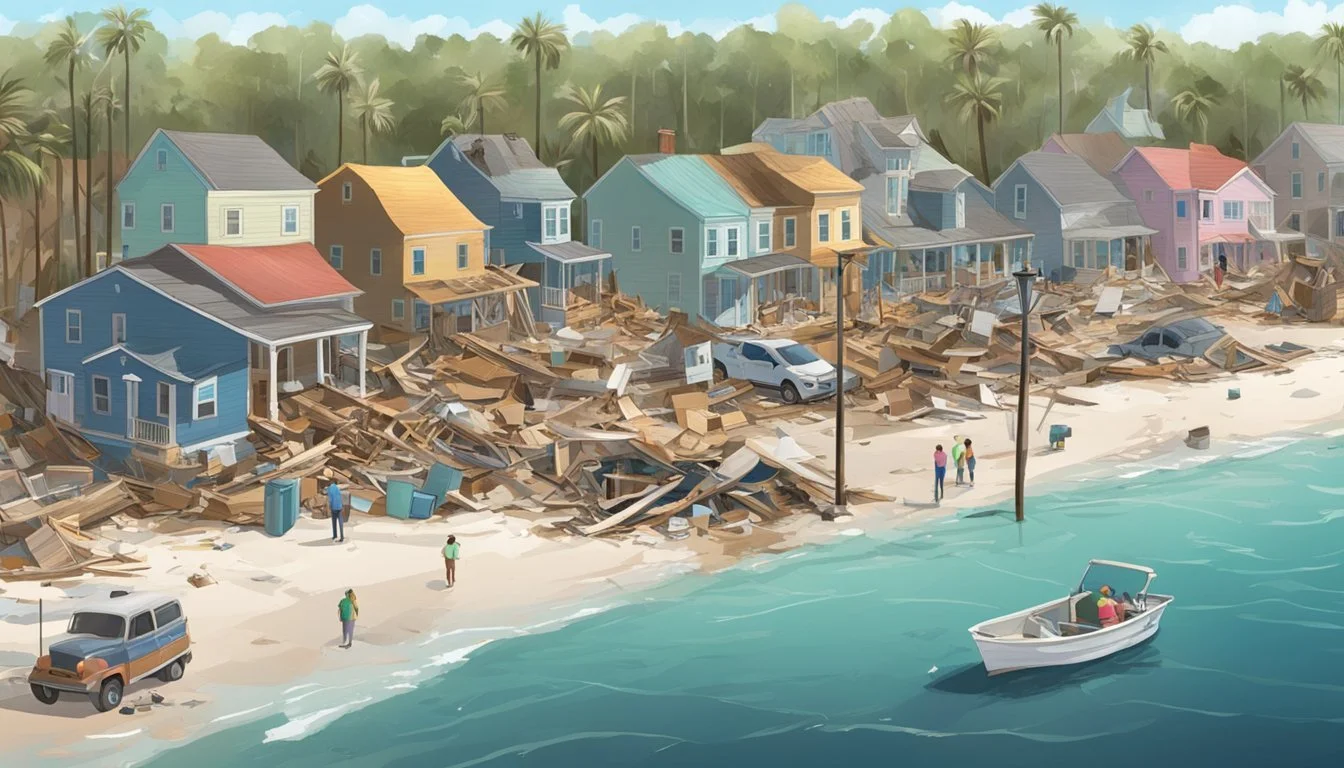6 Hurricane Michael Documentaries That Capture Florida's 2018 Recovery
Insights into Resilience and Rebuilding
Hurricane Michael struck the Florida Panhandle on October 10, 2018, as a Category 5 storm, causing unprecedented devastation. The powerful hurricane left a trail of destruction across Northwest Florida, impacting homes, businesses, and lives. Five years after the disaster, many residents still grapple with the ongoing process of recovery.
Several documentaries have emerged to chronicle the aftermath and long-term effects of Hurricane Michael on Florida's communities. These films offer viewers a unique perspective on the challenges faced by those in the storm's path and the resilience demonstrated during the rebuilding process. From Mexico Beach to Panama City, these documentaries capture the stories of survival, loss, and determination that define the post-Michael landscape.
The documentaries exploring Hurricane Michael's impact provide valuable insights into the complexities of disaster recovery. They showcase the efforts of local residents, volunteers, and government agencies working to restore affected areas. By examining the long-term consequences of the storm, these films also raise important questions about climate change, coastal development, and community resilience in the face of increasingly severe weather events.
The Impact of Hurricane Michael on Florida
Hurricane Michael made landfall as a Category 4 storm on October 10, 2018, devastating Florida's Panhandle region. With wind speeds reaching 155 mph, it was the strongest hurricane to hit the area on record.
The storm's powerful winds and massive storm surge caused catastrophic damage to coastal communities. Mexico Beach bore the brunt of the impact, with many structures completely destroyed or swept away.
Flooding inundated streets and homes across the Panhandle. Storm surge reached up to 14 feet in some areas, pushing seawater far inland and causing extensive erosion.
Bay County suffered severe infrastructure damage. The hurricane knocked out power to over 400,000 customers and disrupted water supplies for weeks in some locations.
Debris littered streets and properties, hampering recovery efforts. The storm's destruction left many residents displaced, with thousands of homes deemed uninhabitable.
Agricultural losses were significant, with timber and cotton crops sustaining major damage. The hurricane's economic impact on the region totaled billions of dollars.
Recovery efforts continue years later, as communities work to rebuild stronger and more resilient infrastructure. The long-term effects of Hurricane Michael serve as a stark reminder of the power of nature.
Response and Recovery Efforts
The aftermath of Hurricane Michael saw a massive mobilization of emergency services, federal agencies, and volunteer organizations. Coordinated efforts focused on search and rescue, restoring critical infrastructure, and providing aid to affected communities.
Emergency Services and FEMA's Role
FEMA quickly deployed personnel and resources to the Florida Panhandle. The agency set up disaster recovery centers to assist residents with applications for federal aid. FEMA coordinated with state and local authorities to assess damage and prioritize relief efforts.
President Trump declared a major disaster, unlocking additional federal funding. This allowed for grants for temporary housing and home repairs. FEMA also provided low-interest disaster loans to cover uninsured property losses.
The agency faced challenges due to the scale of destruction. Some residents reported delays in receiving assistance. Despite this, FEMA's presence was crucial in the early stages of recovery.
Restoration of Electricity and Infrastructure
Hurricane Michael caused widespread power outages across the Florida Panhandle. Utility companies mobilized thousands of workers to restore electricity. Crews faced daunting obstacles, including downed power lines and flooded substations.
Key priorities included restoring power to hospitals, water treatment facilities, and emergency services. Many areas saw power restored within weeks, but some remote locations took longer.
Road clearance teams worked tirelessly to remove debris and fallen trees. This allowed for the reopening of major highways and access to isolated communities. Repairs to damaged bridges and roads continued for months after the storm.
National Guard and Search and Rescue Initiatives
The National Guard played a vital role in the immediate response to Hurricane Michael. Guard members conducted door-to-door searches in heavily impacted areas. They helped evacuate stranded residents and provided security in areas vulnerable to looting.
Search and rescue teams from multiple agencies combed through debris. They used specialized equipment to locate survivors in collapsed buildings. The U.S. Coast Guard conducted aerial searches and water rescues along the coast.
National Guard units also distributed food, water, and supplies to hard-hit communities. They set up temporary shelters and medical facilities to care for displaced residents.
Economic and Social Challenges Post-Michael
Hurricane Michael's devastating impact extended far beyond physical destruction. The storm created a complex web of economic and social challenges that continued to affect Florida's Panhandle long after landfall.
Housing Crisis in the Aftermath
Michael destroyed or severely damaged thousands of homes across the region. This led to an acute shortage of livable housing stock. Many residents were forced to live in temporary shelters or leave the area entirely.
Rent prices skyrocketed due to limited supply. Affordable housing became scarce, particularly impacting low-income families and seniors. Mobile homes, a common housing option in the area, were especially vulnerable to storm damage.
The slow pace of rebuilding exacerbated these issues. Construction delays stemmed from insurance claim disputes, labor shortages, and material costs. This prolonged housing instability for many families.
Impact on Local Businesses and Employment
Local businesses faced significant hurdles in reopening. Many suffered extensive property damage and loss of inventory. Some never recovered, leading to permanent closures.
Tourism, a key economic driver, declined sharply. Hotels, restaurants, and attractions struggled to rebuild and attract visitors. This ripple effect impacted employment across multiple sectors.
Job losses were substantial, particularly in hospitality, retail, and agriculture. Some industries, like construction, saw increased demand. However, overall unemployment rates remained elevated for months after the storm.
Small businesses faced unique challenges in accessing recovery funds and maintaining customer bases. Many operated at reduced capacity or relocated, further straining local economies.
Insurance Disputes and Financial Strain
Insurance claim disputes became a major source of stress for homeowners and businesses. Many found their policies didn't cover all damages or had high deductibles. Some insurers went bankrupt, leaving policyholders in limbo.
Delays in claim processing and payouts hindered rebuilding efforts. This forced many to deplete savings or take on debt to cover immediate expenses. The financial strain led to increased rates of foreclosures and bankruptcies.
Federal aid provided some relief, but navigating the application process proved challenging for many. Gaps in coverage left some residents and businesses struggling to recover financially.
The compounding effects of property damage, job losses, and insurance issues created long-term economic instability for many in the affected areas.
Human Stories of Loss and Resilience
Hurricane Michael's impact on Florida's Panhandle left deep scars on individuals and communities. Survivors faced immense challenges as they worked to rebuild their lives and towns in the storm's aftermath.
Survivors' Experiences and Personal Accounts
Many residents lost everything in the hurricane's fury. Homes were reduced to rubble, treasured possessions washed away, and livelihoods destroyed in an instant.
Some families found themselves living in tents or trailers for months as they struggled to find permanent housing. The trauma of the storm lingered, with many experiencing anxiety and depression.
Despite the hardships, inspiring stories of resilience emerged. Neighbors helped neighbors clear debris and make repairs. Local businesses reopened, providing a sense of normalcy amid the chaos.
Community Efforts and the 'Forgotten Coast'
The Forgotten Coast, a stretch of Florida's Panhandle, bore the brunt of Michael's fury. Small towns like Mexico Beach and Port St. Joe faced a long road to recovery.
Community organizations stepped up to fill gaps in official aid. Churches and nonprofits provided meals, supplies, and emotional support to those in need.
Volunteers from across the country poured in to help with cleanup and rebuilding efforts. Their presence boosted morale and sped up the recovery process.
Local leaders worked tirelessly to secure funding and resources for their communities. They fought to keep their towns' unique character intact while modernizing infrastructure to better withstand future storms.
Long-Term Recovery and Reconstruction
Hurricane Michael's devastating impact on the Florida Panhandle necessitated extensive rebuilding efforts. The recovery process reshaped communities and altered the region's landscape in significant ways.
Rebuilding Infrastructure and Housing
The Florida Panhandle faced immense challenges in reconstructing vital infrastructure. Roads, bridges, and power grids required extensive repairs and upgrades. Many buildings were rebuilt to stricter codes to withstand future storms.
Housing shortages persisted for years after Michael. Temporary shelters transitioned to more permanent solutions as new homes were constructed. However, availability remained limited in some areas.
Insurance payouts and government assistance played crucial roles in funding reconstruction. Some residents chose to relocate, while others committed to rebuilding their communities.
Evolving Landscape and Environmental Impact
Hurricane Michael left lasting scars on the Panhandle's environment. Vast swaths of forests were flattened, altering ecosystems and wildlife habitats. Coastal erosion reshaped shorelines.
Recovery efforts included large-scale replanting initiatives to restore damaged forests. Some areas saw shifts in vegetation types as salt-tolerant species replaced those unable to survive in altered conditions.
Marine environments faced challenges from debris and pollutants washed into waterways. Cleanup efforts continued for years to restore coastal and marine ecosystems.
The changed landscape impacted local industries like agriculture and tourism. Some communities adapted by developing new economic opportunities aligned with the post-hurricane environment.
The Role of Documentary Storytelling in Recovery
Documentaries play a crucial role in capturing the aftermath of natural disasters like Hurricane Michael. These films provide a visual record of the destruction and chronicle the rebuilding efforts.
Through intimate interviews and on-the-ground footage, documentaries bring viewers face-to-face with affected communities. They showcase the resilience of individuals and families working to piece their lives back together.
Documentary filmmakers often spend months or years following recovery efforts. This long-term approach allows them to capture the slow process of healing and reconstruction that occurs after the initial media attention fades.
Many Hurricane Michael documentaries highlight the work of organizations like the National Hurricane Center. They explain storm formation and tracking, educating viewers on hurricane science.
These films also serve as historical documents, preserving first-hand accounts of the disaster. Future generations will be able to learn from the experiences of those who lived through Hurricane Michael's impact.
Documentaries can inspire action by showcasing both needs and success stories. Viewers may be moved to donate or volunteer after witnessing the ongoing challenges faced by recovering communities.
By presenting a range of perspectives, documentaries offer a nuanced view of the recovery process. They explore not just physical rebuilding, but also the emotional and psychological impacts of the storm.




